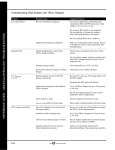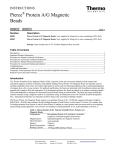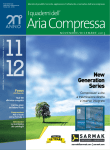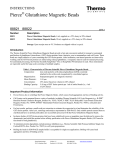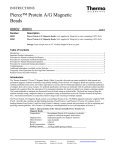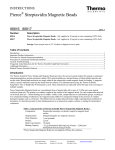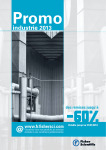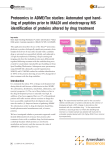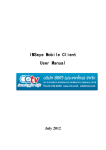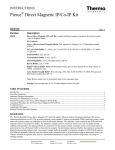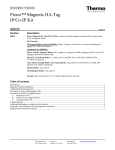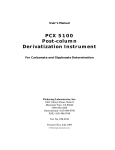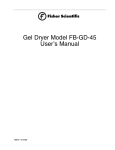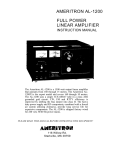Download Pierce Magnetic Titanium Dioxide
Transcript
INSTRUCTIONS Pierce® Magnetic Titanium Dioxide Phosphopeptide Enrichment Kit 88811 88812 2097.0 Number Description 88811 Pierce Magnetic Titanium Dioxide Phosphopeptide Enrichment Kit, contains sufficient reagents for enriching phosphopeptides from 96 complex biological samples Kit Contents: TiO2 Magnetic Beads, 20X, 1 ml Binding Buffer, 100 ml Washing Buffer, 25 ml Elution Buffer, 3 ml Thermo-Fast 96 Robotic PCR Plate, 0.2 ml well volume, 2 plates 88812 Pierce Magnetic Titanium Dioxide Phosphopeptide Enrichment Kit-Trial Kit, contains sufficient reagents for enriching phosphopeptides from 24 complex biological samples Kit Contents: TiO2 Magnetic Beads, 20X, 0.25 ml Binding Buffer, 100 ml Washing Buffer, 25 ml Elution Buffer, 3 ml Thermo-Fast 96 Robotic PCR Plate, 0.2 ml well volume, 2 plates Storage: Upon receipt store at 4°C. Product shipped on an ice pack. Contents Introduction .................................................................................................................................................................................1 Important Product Information ....................................................................................................................................................2 Procedure for Manual Enrichment of Phosphopeptides...............................................................................................................2 Procedure for Automated Enrichment of Phosphopeptides on the KingFisher PCR Plate ..........................................................4 Procedure for Automated Enrichment of Phosphopeptides using Deep-well Plates ...................................................................5 Troubleshooting...........................................................................................................................................................................7 Additional Information ................................................................................................................................................................8 Related Products ..........................................................................................................................................................................9 Reference .....................................................................................................................................................................................9 Introduction Phosphorylation events in complex biological samples are transitory and typically present in low abundance, making them difficult to detect. The Thermo Scientific Pierce Magnetic Titanium Dioxide Phosphopeptide Enrichment Kit uses titanium dioxide-coated magnetic beads to selectively enrich phosphopeptides from complex mixtures such as digested cell lysates. The buffers and assay protocols included are optimized for efficient capture in less than 30 minutes with minimal binding of nonphosphorylated peptides. Purification is achieved either manually using a magnetic stand or by automation using a KingFisher Flex or KingFisher 96 Instrument. Cell signaling networks are invariably dependent upon protein phosphorylation, a reversible post-translational modification, for regulation. Approximately 30% of proteins comprising the eukaryotic proteome are likely to undergo some form of phosphorylation event. Understanding the state of signaling pathways and protein phosphorylation cascades under a variety Pierce Biotechnology PO Box 117 (815) 968-0747 3747 N. Meridian Road Rockford, lL 61105 USA (815) 968-7316 fax www.thermo.com/pierce of conditions is necessary for studying diseases such as cancer. When paired with appropriate sample processing, the identification and quantification of phosphopeptides by mass spectrometry (MS) is a powerful method for studying disease and identifying biomarkers. Samples isolated with this phosphopeptide enrichment kit are ready for direct analysis on a wide variety of MS platforms including the Thermo Scientific LTQ Orbitrap, LTQ and LTQ FT Mass Spectrometers. Important Product Information • A wide variety of methods are used to generate phosphopeptide samples. Optimization of sample stimulation, protein isolation and protein digestion procedures are application-specific; however, for best results, use a phosphatase inhibitor, such as the Thermo Scientific Halt Phosphatase Inhibitor Cocktail (Product No. 78420), throughout the isolation process to prevent rapid loss of phosphorylation events. • Before processing, protein samples need to be reduced, alkylated and digested into peptide fragments. For digestion, use highly specific proteases such as Thermo Scientific MS-grade Trypsin (Product No. 90055) or Lys-C (Product No. 90051). • For efficient sample handling during manual processing, use the 96-well PCR plates provided with the kit and a 96-well magnetic plate separator. • Do not freeze or allow prolonged drying of TiO2 Magnetic Beads. Freezing or excessive drying can cause the beads to lose binding activity. • For analysis by LC-MS/MS, lyophilize the samples as a final step after processing the beads, and reconstitute them in 5% acetonitrile/0.1% formic acid in water. • The sample fractions not bound to the beads can be analyzed by mass spectrometry; however, these samples require additional clean-up, such as drying and C18 desalting. • Avoid phosphate-based buffers during sample preparation because the phosphate anions might interfere with phosphopeptide enrichment. • Peptides containing acidic residues might reduce phosphopeptide enrichment because the carboxyl groups can interact with the TiO2 surface. Methylation of the carboxyl groups before phosphopeptide enrichment can improve recovery of phosphopeptides. See the Additional Information Section for a methylation procedure. • Concentrate and desalt the sample before phosphopeptide enrichment (see the Additional Information Section). Procedure for Manual Enrichment of Phosphopeptides A. Additional Materials Required (see the Related Products Section for ordering information) • 96-well magnetic plate separator • Sample peptide mixture • 50 ml polypropylene conical centrifuge tubes • 15 ml polypropylene conical centrifuge tubes • Acetonitrile • Formic acid • Vacuum concentrator with a 96-well plate rotor B. Prepare the Binding and Washing Buffers Note: Prepare buffers just before each experiment. Binding Buffer Washing Buffer Multiply the number of samples by 1,590 μl to determine the total volume of buffer required. Add 5% for excess. Combine equal volumes of acetonitrile and Binding Buffer in a 50 ml polypropylene conical tube and mix to obtain a homogeneous solution. Close the tube tightly to prevent acetonitrile evaporation. Multiply the number of samples by 200 μl to determine the total volume of buffer required. Add 5% for excess. Combine equal volumes of acetonitrile and Washing Buffer in a 15 ml polypropylene conical tube and mix to obtain a homogeneous solution. Close the tube tightly to prevent acetonitrile evaporation. Pierce Biotechnology PO Box 117 (815) 968-0747 3747 N. Meridian Road Rockford, lL 61105 USA (815) 968-7316 fax 2 www.thermo.com/pierce C. Prepare the TiO2 Magnetic Beads • Use a multi-channel pipettor for dispensing buffers and removing supernatant. • Use 10 μl of 20X TiO2 Magnetic Beads per sample. This volume may be adjusted; however, for best results use a ratio of 1 μl of stock beads to 10 μg of peptide mixture. • To minimize bead loss, leave up to 10 μl of liquid in the wells when removing buffers; however, for the last wash step, completely remove the Washing Buffer from the bead before adding Elution Buffer. 1. (Optional) Before use, rinse all plastic wear (such as the 96-well plates) three times with acetonitrile to minimize contamination from polymers leaching from the plastics. 2. Multiply the total number of samples plus one by 10 μl to determine the total volume of magnetic beads required. Place the determined volume of 20X TiO2 Magnetic Beads into a 50 ml polypropylene conical tube. Note: To ensure homogeneity, mix the vial of 20X TiO2 Magnetic Beads thoroughly before use by repeated inversion, gentle vortexing or rotating platform. 3. Add 190 μl of prepared Binding Buffer for every 10 μl of beads dispensed in Step 2. Screw the cap onto the tube and invert several times to ensure complete suspension of the beads. 4. Pipette 200 μl of the bead suspension into each well of the provided 96-well PCR plate. Note: Periodically mix the bead suspension during dispensing to prevent settling. 5. Place the 96-well plate onto a magnetic plate separator for 1 minute. The beads will collect in the O-ring near the bottom of each well. Use a multi-channel pipettor to remove the supernatant from the center of the wells. 6. Remove the 96-well plate from the magnet. Add 200 μl per well of prepared Binding Buffer to the beads. Do not pipette the beads up and down. Add Binding Buffer quickly to suspend the beads. 7. Repeat Steps 5 and 6 twice. D. Manually Perform the Phosphopeptide Enrichment Note: For best results, desalt the sample peptide mixture on an SPE column or a 96-well device before processing with the TiO2 Magnetic Beads. See the Additional Information Section for protocol. Samples eluted from SPE plates or columns in 80% acetonitrile/0.1% formic acid may be directly applied to beads after adding formic acid to a final concentration of 2%. Note: If sample peptide mixture is not eluted from an SPE device, ensure that the peptide mixture is in a final solution of 80% acetonitrile/2% formic acid before applying to the TiO2 Magnetic Beads. 1. Remove the 96-well plate from the magnet. Add 100 μl of sample peptide mixture per well to the beads and pipette up and down to mix. 2. Place the plate on a magnetic plate separator for 1 minute. Use a multi-channel pipettor to remove the supernatant from the center of the wells. 3. Remove the plate from the magnet and add 200 μl of Binding Buffer (per well) quickly to resuspend the beads. Place the plate on a magnetic plate separator for 1 minute and remove the supernatant. Repeat this step three times. 4. Remove the 96-well plate from the magnet and add 200 μl of Washing Buffer (per well) quickly to resuspend the beads. 5. Place the plate on a magnetic plate separator for 1 minute and remove the supernatant. Completely remove the Washing Buffer before proceeding to the elution step. 6. Remove the plate from the magnet and add 30 μl of Elution Buffer (per well) and pipette up and down a few times to ensure complete coating of the beads with buffer. Incubate at room temperature for 10 minutes. 7. Place the plate on a magnetic plate separator for 1 minute and remove the supernatant containing eluted phosphopeptides. Note: Avoid aspirating the beads with the eluates. Beads may interfere with mass spectrometry analysis. 8. Transfer samples to the unused 96-well PCR plate provided and dry in a vacuum concentrator. For LC-MS analysis using reverse-phase chromatography (e.g., C18), suspend sample in 5% acetonitrile/1% formic acid in water. Alternatively, for MALDI analysis suspend in a matrix of α-cyano-4-hydroxycinnamic acid dissolved in 3% formic Pierce Biotechnology PO Box 117 (815) 968-0747 3747 N. Meridian Road Rockford, lL 61105 USA (815) 968-7316 fax 3 www.thermo.com/pierce acid/50% acetonitrile (prepare on the same day of use). Empirically determine the concentration of MALDI matrix to use. The optimal concentration depends on MS instrument used and final concentration of peptides in sample. Note: Covering the matrix after spotting with 1 μl of 25 mM ammonium citrate may enhance detection of phosphopeptides in MALDI-MS analysis. Procedure for Automated Enrichment of Phosphopeptides on the KingFisher PCR Plate A. Additional Materials Required (see the Related Products Section for ordering information) • KingFisher Flex or KingFisher 96 Instrument with PCR Magnet Head • KingFisher Flex 96 Tip Comb for PCR Head Magnets • Thermo Scientific Thermo-Fast 96 Robotic PCR Plate, 0.2 ml well volume • Sample peptide mixture • 50 ml polypropylene conical centrifuge tubes • 15 ml polypropylene conical centrifuge tubes • Acetonitrile • Formic Acid • Vacuum concentrator with a 96-well plate rotor B. Prepare the KingFisher Instrument Note: The following protocols are designed for general use with the KingFisher Flex or KingFisher 96 Instruments. If desired, the protocols can be modified as needed using the BindIt™ Software provided with the instrument. 1. Download the “Phosphopeptide Enrichment PCR Plate” protocol from the web site (www.thermo.com/kingfisher) into the BindIt Software on an external computer. 2. Transfer the protocol to the KingFisher Instrument from an external computer. See BindIt Software User Manual for detailed instructions on importing protocols. C. Prepare the Binding and Washing Buffers Note: Prepare buffers just before each experiment. Binding Buffer Washing Buffer Multiply the number of samples by 510 μl to determine the total buffer volume required. Add 5% for excess. Combine equal volumes of acetonitrile and Binding Buffer in a polypropylene conical tube (15 ml or 50 ml) and mix to obtain a homogeneous solution. Close tube tightly to prevent acetonitrile evaporation. Multiply the number of samples by 130 μl to determine the total buffer volume required. Add 5% for excess. Combine equal volumes of acetonitrile and Washing Buffer in a 15 ml polypropylene conical tube and mix to obtain a homogeneous solution. Close tube tightly to prevent acetonitrile evaporation. D. Prepare the TiO2 Magnetic Beads and Plate Set-up Note: The following protocol is for processing less than 1 mg of peptide mixture. The protocol uses 10 μl of 20X TiO2 Magnetic Beads per sample. This volume can be adjusted; however, for best results, use a ratio of 1 μl of stock beads to 10 μg of peptide mixture. 1. (Optional) Rinse all plastic wear (such as the 96-well plates) three times with acetonitrile to minimize contamination from leached polymers. 2. Multiply the total number of samples plus one by 10 μl to determine the total volume of magnetic beads required. Place calculated volume of 20X TiO2 Magnetic Beads into a 15 ml polypropylene conical tube. Note: To ensure homogeneity, mix the vial of 20X TiO2 Magnetic Beads thoroughly before use by repeated inversion, gentle vortexing or rotating platform. Pierce Biotechnology PO Box 117 (815) 968-0747 3747 N. Meridian Road Rockford, lL 61105 USA (815) 968-7316 fax 4 www.thermo.com/pierce 3. Add 120 μl of prepared Binding Buffer for each 10 μl of beads dispensed in Step 2. Screw the cap onto the tube and invert several times to ensure complete suspension of the beads. 4. Set up the plates according to Table 1, which will subsequently be placed into a KingFisher Instrument. Table 1. Pipetting instructions for the Phosphopeptide Enrichment PCR Plate Protocol using the Thermo-Fast 96 Robotic PCR Plates. Plate Name Content Plate # Volume (μl)/well KingFisher Flex 96 Tip Comb 1 Tip Plate for PCR Magnet Head 2 Beads TiO2 beads in Binding Buffer 130 3 Bead Wash Binding Buffer 130 Sample peptide mixture in 80% 4 Sample 100 acetonitrile/2% formic acid 5 Sample Wash Binding Buffer 130 6 Sample Wash Binding Buffer 130 7 Sample Wash Washing Buffer 130 8 Elution Elution Buffer 30 E. Perform the Phosphopeptide Enrichment PCR Plate Protocol 1. Select the protocol using the arrow keys in the instrument keypad and press Start. See KingFisher User Manual for detailed information. 2. Slide open the door of the protective cover on the instrument. Load plates 1-8 into the instrument according to the protocol request and confirm each action by pressing Start. Place each plate in the same orientation. 3. Press Start to initiate the protocol. 4. After the samples are processed, remove the plates as instructed by the display on the instrument. Press Start after removing each plate. 5. Press Stop after all plates are removed. 6. Transfer samples to a new PCR plate and lyophilize to dryness using a vacuum concentrator. 7. For LC-MS/MS analysis, rehydrate each sample in 5% acetonitrile/1% formic acid in water and inject each sample directly from the 96-well plate. Alternatively, for MALDI analysis resuspend samples in α-cyano-4-hydroxycinnamic acid MALDI matrix solution and spot onto a MALDI chip. Procedure for Automated Enrichment of Phosphopeptides using Deep-well Plates A. Additional Materials Required (see the Related Products Section for ordering information) • KingFisher Flex or KingFisher 96 Instrument with 96 Deep Well Head • Microtiter Deep Well 96 Plate, V-bottom, polypropylene • KingFisher Flex 96 tip comb for Deep Well magnets • Sample peptide mixture • 50 ml polypropylene conical centrifuge tubes • 15 ml polypropylene conical centrifuge tubes • Acetonitrile • Formic acid • Vacuum concentrator with a 96-well plate rotor Pierce Biotechnology PO Box 117 (815) 968-0747 3747 N. Meridian Road Rockford, lL 61105 USA (815) 968-7316 fax 5 www.thermo.com/pierce B. Prepare the King Fisher Instrument Note: The following protocol is for general use with the KingFisher Flex or KingFisher 96 Instrument. Modify the protocol as needed using the BindIt Software provided with the instrument. 1. Download the “Phosphopeptide Enrichment Deep Well” protocol from the web site (www.thermo.com/kingfisher) into the BindIt Software on an external computer. 2. Transfer the protocol to the KingFisher Instrument from the external computer. See BindIt Software User Manual for detailed instructions on importing protocols. C. Prepare the Binding and Washing Buffers Note: Prepare buffers just before each experiment. Binding Buffer Multiply the number of samples by 3.9 ml to determine the total buffer volume required. Add 5% for excess. Combine equal volumes of acetonitrile and Binding Buffer in a 50 ml polypropylene conical tube and mix to obtain a homogeneous solution. Close the tube tightly to prevent acetonitrile evaporation. Washing Buffer Multiply the number of samples by 1 ml to determine the total buffer volume required. Add 5% for excess. Using this number, combine equal volumes of acetonitrile and Washing Buffer in a 15 ml polypropylene conical tube and mix to obtain a homogeneous solution. Close the tube tightly to prevent acetonitrile evaporation. D. Prepare the TiO2 Magnetic Beads Note: The following protocol is recommended when processing a minimum of 1 mg of peptide mixture. The protocol uses 100 μl of 20X TiO2 Magnetic Beads per sample. This volume can be adjusted; however, a ratio of 1 μl of stock beads to 10 μg of peptide mixture is recommended. 1. (Optional) Rinse all plastic wear to be used (such as the 96-well plates) three times with acetonitrile to minimize contamination from polymers leaching from the plastics. 2. Determine the total number of samples to be processed. Multiply the total number of samples plus 0.5 by 100 μl to calculate the total volume of magnetic beads required. Place the calculated volume of 20X TiO2 Magnetic Beads into a 15 ml polypropylene conical tube. Note: To ensure homogeneity, mix the vial of 20X TiO2 Magnetic Beads thoroughly before use by repeated inversion, gentle vortexing or rotating platform. 3. Add 900 μl of prepared Binding Buffer per sample (+ 0.5) to the tube. Screw the cap onto the tube and invert several times to ensure complete suspension of the beads. 4. Set up the plates according to Table 2 which will subsequently be placed into the KingFisher Instrument. Table 2. Pipetting instructions for the Phosphopeptide Enrichment using the Microtiter Deep Well 96 Plates. Plate Name Content Plate # Volume (μl)/well KingFisher Flex 96 Tip Comb 1 Tip Plate for Deep Well Magnets 2 Beads TiO2 beads in Binding Buffer 1,000 3 Bead Wash Binding Buffer 1,000 Sample peptide mixture in 80% 4 Sample 1,000 acetonitrile/2% formic acid 5 Sample Wash Binding Buffer 1000 6 Sample Wash Binding Buffer 1,000 7 Sample Wash Washing Buffer 1,000 8 Elution Elution Buffer 150 Pierce Biotechnology PO Box 117 (815) 968-0747 3747 N. Meridian Road Rockford, lL 61105 USA (815) 968-7316 fax 6 www.thermo.com/pierce E. Perform the Phosphopeptide Enrichment Deep-well Plate Protocol 1. Select the protocol using the arrow keys in the instrument keypad and press Start. See the KingFisher User Manual for detailed information. 2. Slide open the door of the instrument’s protective cover. Load plates 1 through 8 into the instrument according to the protocol request, placing each plate in the same orientation. Confirm each action by pressing Start. 3. Press Start to initiate the protocol. 4. After the samples are processed, remove the plates as instructed by the display on the instrument. Press Start after removing each plate. 5. Press Stop after all plates are removed. 6. Transfer samples to a new PCR plate and lyophilize to dryness using a vacuum concentrator. 7. For LC-MS/MS analysis, rehydrate each sample in 5% acetonitrile/1% formic acid in water and inject each sample directly from the 96-well plate. Alternatively, for MALDI analysis resuspend samples in α-cyano-4-hydroxycinnamic acid MALDI matrix solution and spot onto a MALDI chip. Troubleshooting Problem Lack of phosphopeptides identified Possible Cause Dephosphorylation occurred during isolation and processing Poor cell health or improper stimulation to induce phosphorylation events Low amount of phosphorylation events in the sample Interference from inorganic phosphates or highly buffered starting material prevented binding buffer from adjusting sample to the required conditions Improper MS instrument setting Neutral loss of phosphate groups causing poor MS/MS phosphopeptide sequencing Identification of a large numbers of nonphosphorylated peptides Sample digestion incomplete Sample contains highly acidic peptides Insufficient washing Highly buffered starting material prevented the binding buffer from adjusting sample to the required conditions Solution Include phosphatase inhibitors during sample preparation Check cell health and growth and confirm stimulation by Western blot Increase amount of starting material being processed Use phosphate-free buffers, dilute sample with binding buffer or change sample preparation method Use control phosphopeptides (e.g., digested α-casein) to determine optimal instrument settings Perform neutral loss scan and MS3 experiments or, on ETD-equipped instruments, use ETD fragmentation to preserve phosphorylation events Monitor sample digestion by SDS-PAGE Methylate sample peptide mixture before processing (see Additional Information Section) Perform an additional wash Dilute sample with binding buffer or change sample preparation method Pierce Biotechnology PO Box 117 (815) 968-0747 3747 N. Meridian Road Rockford, lL 61105 USA (815) 968-7316 fax 7 www.thermo.com/pierce Additional Information • Visit www.thermo.com/pierce for additional information including the following: ο Tech Tip #43: Protein Stability and Storage • Visit www.thermo.com/kingfisher for information on KingFisher Products. • In the U.S.A., purchase KingFisher Supplies from VWR. Contact your local Thermo Fisher Scientific office to purchase KingFisher Supplies outside the U.S.A. A. Procedure for Methylation of Carboxyl Groups Note: The presence of significant amounts of highly acidic peptides may hinder phosphopeptide enrichment and detection because of carboxyl groups interacting with the TiO2 surface. To minimize this interaction, methylate the carboxyl groups before phosphopeptide enrichment. Methylation is not recommended for all samples as nonspecific binding is typically low and methylation significantly increases the difficulty of data analysis. 1. Lyophilize a peptide sample and dissolve it in 1 ml of 3 N methanolic HCl. Incubate the reaction for 60 minutes at room temperature. Note: Use prepared 3 N methanolic HCl that is provided in glass ampules (e.g., Sigma Product No. 32355). 2. Lyophilize the sample to remove the solvent. 3. Dissolve the peptides in up to 1 ml of 80% acetonitrile/0.1% formic acid and proceed to enrichment of phosphopeptides using the Pierce Magnetic TiO2 Phosphopeptide Enrichment Kit. B. Sample Concentration and Desalting Using Solid Phase Extraction Cartridges or 96-Well Plates Note: Sample concentration and desalting is recommended before enrichment with the Pierce Magnetic TiO2 Phosphopeptide Enrichment Kit. To process up to 2 mg of peptides, use the Thermo Scientific HyperSep SPE Columns or Thermo Scientific Hypersil C18 96-well Plates (see the Related Products Section for ordering information). 1. Rinse each SPE cartridge or well with one full volume of acetonitrile. 2. Rinse each SPE cartridge or well with one full volume of 0.25% TFA in water. Repeat this step twice. 3. Load peptide digest sample onto SPE cartridge or wells at a flow rate of 1 ml per minute. 4. Rinse each SPE cartridge or well with one full volume of 0.25% TFA in water. Repeat this step four times 5. Elute the desalted peptide samples in 80% acetonitrile/0.1% formic acid. 6. Add formic acid to eluted peptide sample to a final concentration of 2%. Add samples directly to TiO2 beads. Pierce Biotechnology PO Box 117 (815) 968-0747 3747 N. Meridian Road Rockford, lL 61105 USA (815) 968-7316 fax 8 www.thermo.com/pierce Related Products Products available from www.thermo.com/pierce 28905 Formic Acid, 10 × 1 ml ampules 21358 MagnaBind™ Magnet for 96-Well Separator 21357 MagnaBind Magnet for one 1.5 ml Microcentrifuge Tube 21359 MagnaBind Magnet for 6 Microcentrifuge Tubes 88800, 88801 Pierce Protein A Magnetic Beads 88806, 88807 Pierce Protein G Magnetic Beads 88821, 88822 Pierce Glutathione Magnetic Beads Products available from www.thermo.com SC250EXP-115 Express SpeedVac Concentrator SC250 Products available from www.thermo.com/abgene AB1300 Thermo-Fast 96 Robotic PCR Plate, 0.2 ml well volume Products available from www.fishersci.com 14-432-22 50 ml Polypropylene Conical Centrifuge Tubes 14-959-49B 15 ml Polypropylene Conical Centrifuge Tubes A955-1 Acetonitrile, 1 L 60108-304 HyperSep SPE Columns 60300-428 Hypersil C18 96-well Plates Products available from www.vwr.com 5400630 KingFisher Flex with 96 Deep Well Head Instrument 97002514 KingFisher Flex 96 Tip Comb for PCR Head Magnets 95040450 Microtiter Deep Well 96 Plate, V-bottom, polypropylene 97002534 KingFisher Flex 96 Tip Comb for Deep Well Magnets Reference 1. Hubbard, M.J. and Cohen, P. (1993). On target with a new mechanism for the regulation of protein phosphorylation. Trends Biochem. 18:172. Limited Use License This product is distributed and sold to the End-User pursuant to an appointment grant from PerkinElmer LAS, Inc. to Thermo Fisher Scientific, Inc. for use of PerkinElmer’s Phos-trap® technology for life science research applications, but not diagnostics applications. Any use of this product other than the licensed use without the express written authorization of PerkinElmer LAS, Inc. and Thermo Fisher Scientific, Inc. is strictly prohibited. This product (“Product”) is warranted to operate or perform substantially in conformance with published Product specifications in effect at the time of sale, as set forth in the Product documentation, specifications and/or accompanying package inserts (“Documentation”) and to be free from defects in material and workmanship. Unless otherwise expressly authorized in writing, Products are supplied for research use only. No claim of suitability for use in applications regulated by FDA is made. The warranty provided herein is valid only when used by properly trained individuals. Unless otherwise stated in the Documentation, this warranty is limited to one year from date of shipment when the Product is subjected to normal, proper and intended usage. This warranty does not extend to anyone other than the original purchaser of the Product (“Buyer”). No other warranties, express or implied, are granted, including without limitation, implied warranties of merchantability, fitness for any particular purpose, or non infringement. Buyer’s exclusive remedy for non-conforming Products during the warranty period is limited to replacement of or refund for the non-conforming Product(s). There is no obligation to replace Products as the result of (i) accident, disaster or event of force majeure, (ii) misuse, fault or negligence of or by Buyer, (iii) use of the Products in a manner for which they were not designed, or (iv) improper storage and handling of the Products. Current versions of product instructions are available at www.thermo.com/pierce. For a faxed copy, call 800-874-3723 or contact your local distributor. © 2008 Thermo Fisher Scientific Inc. All rights reserved. Unless otherwise indicated, all trademarks are property of Thermo Fisher Scientific Inc. and its subsidiaries. Printed in the USA. Pierce Biotechnology PO Box 117 (815) 968-0747 3747 N. Meridian Road Rockford, lL 61105 USA (815) 968-7316 fax 9 www.thermo.com/pierce









